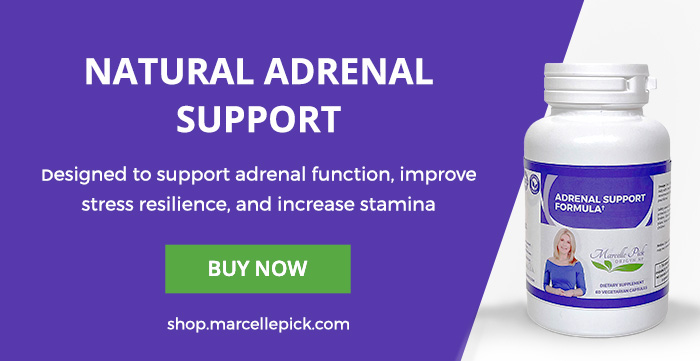Updated: Oct. 29, 2023
“My GI issues are what brought me here, but there’s something else I just can’t put my finger on. I simply don’t feel like myself!”
That’s what Missy said when she first came to see me. She’d tried talking to her primary care doctor, but felt rushed and unheard. Like many of the women I work with, Missy was very self-aware and motivated – both extremely important qualities to help women through the journey of healing.
She came to me because she’d heard that functional medicine was different; and it is! We don’t want to skip over any detail when it comes to a patient’s health. That’s why we take comprehensive histories, spend way more time talking with our patients than conventional physicians do, and often make use of specialized lab tests.
Although Missy said she was generally happy, she described a high-stress workplace as well as ongoing marital struggles. Of course, these are red flags already, especially when you know how much of an influence stress has on health! But one of my biggest clues to what might be the problem came when she said that she feels like she doesn’t even react to stress anymore.
For example, she told me that while she used to feel really panicky when she faced criticism from her boss, now she just sort of felt nothing but tired in those situations. This was an instant signal to me that she was not only going through adrenal dysfunction, she was likely in the later stages.
Chronic stress is so common in our world, so I find that just about all of my patients have some degree of adrenal dysfunction. But what does that mean?
Understanding and recognizing how far adrenal fatigue has progressed and what stage someone is in can make a huge difference when it comes to treatment and recovery.
The different stages each have different kinds of imbalances and different symptoms, and they may surprise you!
Misconceptions about adrenal fatigue
People commonly misunderstand what adrenal fatigue is and what it means. That’s why it’s important to dispel some of the misconceptions right off the bat.
Because adrenal fatigue occurs due to chronic stress, or chronic illness and because it disrupts our levels of the “stress hormone” cortisol and our stress response, it can get a little bit pigeonholed.
Many people are surprised to learn that the adrenal glands are actually responsible for producing more than 50 crucial hormones– not just cortisol! I’m talking about other stress-related hormones like adrenaline and norepinephrine, but also sex hormones like estrogen and testosterone, and the parent hormone DHEA.
Adrenal dysfunction disrupts all of these hormones and all of their functions, which helps to explain why the symptoms and effects of this condition can be so complex and widespread.
Another confusing thing about adrenal fatigue is the term itself! It doesn’t really describe the broad spectrum of adrenal dysfunction that I see on a daily basis. Actually, adrenal “fatigue” or exhaustion, as we think of it, doesn’t really happen until the later stages of adrenal dysfunction (even though we can feel fatigue as a symptom even in the early stages).
This brings me to another important point, and one of the reasons I feel so strongly about working with a functional medicine practitioner who is experienced with hormonal imbalances and adrenal fatigue if you’re experiencing any relevant symptoms.
When we talk about the different stages of adrenal fatigue, we’re not talking about one biomarker or level of one thing getting progressively worse in a linear fashion. The different stages come with unique patterns of hormone levels and imbalances, and cortisol to DHEA ratios.
Recognizing the stages of adrenal fatigue can make a major difference when it comes to determining the best treatment plan and healing before things get any worse.
How Many Stages of Adrenal Fatigue Are There?
One of the complicated things about adrenal fatigue is that there’s not always agreement on the basics – and this is a great example. Different people have different answers to the question on stages. Functional medicine practitioners are generally in agreement about what the progression of adrenal dysfunction looks like from early to advanced, but while some will divide it into as few as two broad stages, others will break it down into as many as seven.
As a practitioner, I think there’s a big benefit in really understanding the “mini” stages within the stages. But to keep things digestible, we can organize them into four main stages of adrenal fatigue.
Not everybody with adrenal fatigue advances to stage 4, which is great news. If it’s uncovered early enough, and if the right diet and lifestyle changes are made, it’s very possible to bounce back from the first or second stage. It’s possible to come back from any stage, but the more advanced the dysfunction is, the more work there is to be done first.
Stage one: the stress response
This first stage of adrenal fatigue is actually just the normal response to acute stress. We can almost think of it as kind of a “stage zero”! This is the natural response to a stressful situation or an emergency, and it doesn’t necessarily represent or signal any dysfunction to come.
The problem arises if the stress doesn’t subside, or more stress is piled on. Then, your body will move into the next stage. So in this sense, even though it isn’t problematic on its own, the stress response is still the first stage of adrenal fatigue.
Our normal stress response is what we go through when we’re faced with real or a perceived danger or a stressful situation of any kind (anything from being chased by a bear to going on a first date).
This response involves the release of higher levels of hormones like cortisol, adrenaline, and norepinephrine. These hormones help to keep us alert, focused, energized, and able to deal with (or fight, or run from) a stressful situation. During this stage, we also release higher levels of DHEA, and higher levels of insulin.
Because this isn’t a place of dysfunction, you probably won’t be be experiencing many symptoms. However, you might notice fluctuating energy levels (sometimes a jittery feeling) or difficulty sleeping. It’s also possible to go through mild digestive issues, because digestion takes a backseat when we have a stressful situation on our hands that our bodies need to be dealing with.
Stage two: constant alarm mode
Stage two occurs when the high levels of stress we’re responding to don’t go away. Maybe it’s one or two persistent stressful situations (i.e. constant stress at work or at home), or maybe it’s a constant buffet of “little” environmental stressors and triggers. It could also be the aftermath of a traumatic event.
You know that feeling of being “tired but wired”? That’s classic stage two! You might feel either intermittently exhausted or constantly tired, but you’re powering through it. You might be hitting the coffee pot or the sugary snacks hard in order to keep going.
Many women are so used to meandering in and out of these periods of high stress that they don’t even really notice that anything is wrong. That’s why I always take it really seriously when I find out that someone is living a high-stress lifestyle or relying heavily on caffeine, even if they feel relatively normal.
So, what’s going on in the body during stage two? Well, we’re still producing tons of our infamous stress hormone, cortisol. But at this point, our levels of other hormones like DHEA may be starting to drop, because our adrenal glands are focused on pumping out enough cortisol to get us through.
Beyond the “tired but wired” feeling or frequently “crashing”, symptoms during this phase may include difficulty sleeping, feelings of anxiety, restlessness, and increased frequency of coming down with viruses or infections.
Stage three: the resistance phase
This tends to be where the more extreme levels of fatigue and bigger impact on quality of life start to set in. The body is adapting to chronic stress as the norm, and every system in the body is suffering as a result.
The really important thing to understand here is that the body takes stress very, very seriously. Our adrenal glands and the rest of our stress response system have no way of knowing whether our stress is actually caused by a hectic schedule and intake of fried food or if it’s being caused by an impending wild animal attack.
Regardless of what’s causing the prolonged stress, the body is trying to protect us, and any stress has the potential to be a life or death situation as far as the adrenals are concerned.
Because of this, our hormonal system and adrenal glands basically make the decision that most other things– reproduction, digestion, immune function– can wait.
A phenomenon that happens during this stage is called the “pregnenolone steal”. Pregnenolone is a compound that can be used to create either cortisol, progesterone, or DHEA (DHEA can then be used to produce the sex hormones estrogen and testosterone).
So, when we’re going through periods of chronic, prolonged stress, and we’ve been pumping out cortisol in massive amounts, pregnenolone cuts way back on the progesterone and DHEA production, and focuses instead on making more and more cortisol.
This means we can end up producing insufficient sex hormones. Lab tests done during this time are likely to show high levels of cortisol, but low levels of a bunch of other essential hormones, from DHEA to estrogen.
Symptoms during this stage might include constantly feeling tired, trouble focusing, moodiness or irritability, low sex drive, and trouble sleeping. The hormonal imbalances and deficiencies can lead to additional concerns like infertility, worsened PMS, and insulin resistance or blood sugar imbalances.
Stage four: burnout
I think stage four is what many people think of when they hear the term “adrenal fatigue”. After a long stretch of producing lots and lots of cortisol at the expense of other hormones and beyond their normal capacity, the adrenal glands and the body finally burn out.
During this stage, we don’t stop producing cortisol altogether, but we are producing low levels. We’re also still producing low levels of DHEA and our sex hormones, and we’re likely to also be producing low levels of important neurotransmitters.
Symptoms can include exhaustion or extreme/constant fatigue, irritability, depression, anxiety, low sex drive, brain fog, and severe hormonal imbalances. During this stage, many women find that their day-to-day life and tasks become very challenging.
Other conditions may appear or worsen because of the toll taken on the body. Autoimmune conditions, digestive disorders, and conditions related to hormonal balance and fertility are possible. Many women who reach this stage of adrenal fatigue also have leaky gut, like Missy did.
At this point, even if exposure to stress has been reduced, the body needs a lot of support to get back to a healthy and functional place. Taking a DHEA supplement is often recommended.
Testing for adrenal fatigue stages
So how do I determine what stage of adrenal fatigue someone is in? It’s a combination of taking a detailed history and understanding their symptoms and history, with the help of comprehensive hormonal lab tests.
I’m not just looking at levels of cortisol when I do this kind of testing. I want to understand the ratio of cortisol to DHEA, and the levels of other hormones, to understand more clearly how far adrenal fatigue has progressed, and what is going on in the body because of it. I also want to look at patterns of cortisol levels throughout the day.
This is all so helpful when it comes to developing the right treatment plan for an individual, in order to balance their hormones, restore adrenal function, and get to a place of wellness and vitality. The more we understand about what’s going on in the body and where the imbalances are, the more we can do about it!
I went through this whole process with Missy, and realized she was in stage 4. I knew it would take a lot of work, but she was willing to do what was necessary. It didn’t happen overnight, but Missy was able to restore her health once she understood just what she was dealing with – and you can too!








